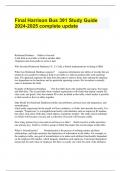Exam (elaborations)
Final Harrison Bus 391 Study Guide complete update
- Course
- Institution
Final Harrison Bus 391 Study Guide complete update Relational Database •Tables of records •Link field in one table to field in another table •Separates data from paths to retrieve data Who Invented Relational Databases? E. F. Codd, a British mathematician working at ...
[Show more]



